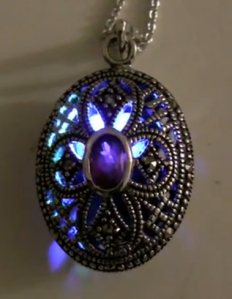[Andrey] from RTFM has built himself a glowing LED pendant using only three parts and some simple code. The hack is not particularly complicated but [Andrey] provides some decent instructions on Pickaxe programming via an RS232 serial port and RGB LED control to produce the nice glowing effects. The pendant contains an RGB LED, a Pickaxe-08 microcontroller and a couple of button cell batteries. To cram everything inside the locket, [Andrey] had to grind down the LED and Pickaxe-08 to their minimum dimensions using a file.
All of the Basic code for the pendant is supplied on the project page and [Andrey] describes how he manages to PWM all three LED pins for the colour effects. The video after the break may be of interest to anyone who has not had a go at Picaxe programming before or for a beginner who wants to try out some new embedded devices without a big hit to the wallet.
[youtube=http://www.youtube.com/watch?v=hzSyRVETA8Y&feature=player_embedded&w=470]
















Did you misspell PICAXE as PICKAXE ;)
Nice idea.
It would be cooler to have this running from a renewable energy source though. Maybe an energy store charged by the movement of the user, heat from the body (?) or even a small solar panel.
PICAXE. (I’m not yelling, it’s supposed to be capitalized, also.)
Nice job fitting all that in there. I think I’d go for something different for the light pattern, but that’s easy enough to change.
should have went further and made the jewel a button to change patterns.
It’s a nice start to something cool.
It’s official. No one makes smd capacitors anymore.
Wife likes the aesthetics of it enough, but I still wince when code is involved with a blinking led. LED for Mike ;)
Congrats on the build and figuring out the code, though.
Not to diminish anything about it, and recognizing the advances of doing it yourself I’d like to mention that in dollar stores and toy stores they sell various ‘magic wand’ and such toys that actually have the whole effect and controller on a tiny PCB inside them, so if you are lazy you could just purchase one of those and mod it into a more fancy enclosure like this pendant.
They often have 3 colors of very bright LED in the 3mm or SMD variants so it’s handy to have the whole material list in one single 1 or 2 dollar buy.
Those toys are also handy to mod for adding effects to computercases or bicycles and so forth, especially since some of them rely on a persistence-of-vision effect as you wave them around.
Nice project.
I worry about the battery life, however. Most RGB LEDs have a forward bias voltage of ~3.4 V for the GB channels. New button batteries will barely give you that.
i’ve done something similar with flesh tunnels and attiny45’s, they run on a coin cell for about 2 days before dying. Cant imagine this is much different
@blue carbuncle – today they’re blinking 3 LEDs; tomorrow they’re embedding a micro controller in a project that needs it and writing their own open source code. Beginners need somewhere to start.
Having said that – some of the beginners would probably like some really simple LED flasher circuits.
@tom: you put an AVR where?
@chango – lol; in an ear piercing
tom: attiny45 has 4 PWM channels, PICAXE has just one. Because the PWM is implemented software way in this project it lasts less, still has enough juice for a few hours.
Whatnot: there are also 2-pin RGB LEDs on ebay for a few buck per pound. The “slow” version of that LED produces effect similar to to what this project does. However it’s less fun because it is not programmable and not DIY :)
I also wanted this project to be a 5-minute quick start guide to the simplest affordable microcontroller out there (attinies are as cheap but a bit complicated because they need programmer).
fartface: unfortunately the button didn’t fit the package. I have an attiny85 version of this – it changes the patterns. That episode is coming later.
Just a minor quibble, he should have used some hot glue in the design to difuse the light from the LED.
Off making mine with 555, blackjack… well, you got the idea.
Anyway, awesome idea.
aww I was really hoping it had biofeedback control of the RGB…..Glowing Mood Necklace would have been neat.
Techartisan: coming soon :) I have the prototype working.
Andrey:
Fyi, reminds me to someone elses similar project goal that I saw, but with more ‘parts’…
http://www.flickr.com/photos/37996583811@N01/5873071291/in/photostream
Hey, can anyone recommend a way for me to do this easily? I really don’t want to go through all this work for a few hours of battery life, and I need the power source to be replaceable (or at least the entire interior to be easily replaceable). I just honestly want a glowing locket, and I want to be able to keep it glowing.